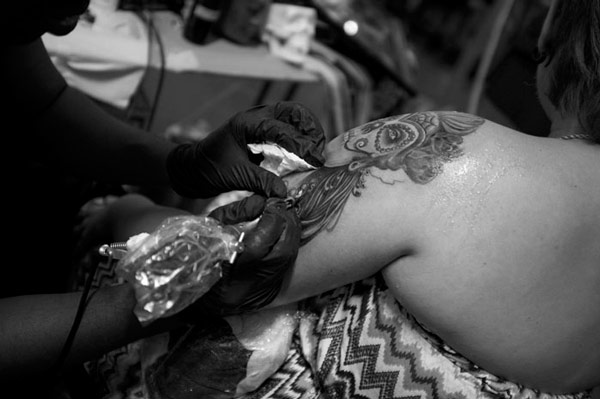Havana’s Sixth “Love-In” Fest Report
Regina Cano (Fotos: Elio Delgado Valdes)
HAVANA TIMES — Havana’s historic Morro Cabaña fortress was the stage of the Sixth Love-In for Peace and the Environment Festival, dedicated to women this year. It took place on November 15-16.
The festival took place in the pavilions surrounding San Francisco Square, where a stage for evening performances was set up.
There, the public was treated to photo, painting and sculpture exhibitions and visual arts installations. Festival goers were also able to buy crafts, listen to rock and electronic music, get free massages and tattoos, participate in a “cosplay” contest, attend conferences and enjoy sweets and other snacks.

These venues closed at 9 pm, when the concerts (which lasted until approximately 3 am) began. This was a curious decision, for Havana’s public transportation system is practically dead that early in the morning and the Morro complex is on the other side of the bay.
There was a fairly large turnout, particularly at the concerts, which saw more people on Saturday than Friday. The crowd (mostly young) was mixed: there, you were as likely to run into the average Joe as into the hotties, rockers, Rastafarians, clubbers and even intellectuals and artists.
In the afternoons, capoeira performances, a bicycle polo match and even a fashion show for garments made using recycled materials (a project organized by students from the Higher Institute of Design) were staged outdoors. Performance artists and actors were also seen.
One of the most surprising things, for me, was seeing that the call to take better care of the environment made at the festival apparently fell upon deaf ears among attendees, for the festival grounds began to be covered up by empty pop and beer cans as the hours passed (as some of us who stumbled upon these with disquieting regularity noticed).
If the festival’s intention was to expose us to cultural diversity, the kind that overwhelms the senses and makes one want to revisit some things with more time (something that tends to happen with most forms of entertainment), then it accomplished its objective.
One of the most popular venues, next to the Manga and massage locales, was the Frida Kahlo salon, where tattoo artists indulged the public without catching a single break during the two days of the festival.
The pavilions, surrounded by common walls, are covered by vaulted roofs fitted with openings for ventilation. The acoustics there are not exactly good and there’s often a strong echo. The music venues, like the tattoo and other rooms, were isolated from the rest and from each other, but, despite this, it was difficult to hear speakers, whose voices were muffled by the rumble of surrounding spaces and other external sounds.

The Manga venue – one of the more popular – held a caligraphy workshop, cosplay and anime no kenyuu contest. A pleasant café area was set up and origami, paper craft, porcelain and traditional Japanese garment exhibitions enlivened the venue.
The John of Arc venue held a photo, painting and installation exhibition as part of several artistic projects.
At the Nina Simone venue, audiences were treated to rock music, while electronic music concerts were staged at the Blue Base venue.
The group Vandana Shiva offered conferences on such topics as Yoga, eco-feminism, Cuban science fiction women writers, menstruation and female nature and others. They also offered pastry cooking lessons, courtesy of the Arca de Noe bakery.
The Teresita Fernandez children’s area was covered with a circus tent. Eric Maza and Juan Davil treated the public to relaxing massages at the Chavela Vargas venue. The other half of the venue was taken up by a photo exhibit by Yeni Sanchez and Lissette Padilla. Readings by authors Osdalgia, Amehel and Yoss were also organized there. The small space attracted a small audience (around ten people), for the eagerness to see all other venues kept people moving.
In a space set up in the middle of the Chavela venue, were a number of impressive sculptures made out of vegetables (authored by Gabriel Coto).
The Duo Jade, Victoria Sol, Yimi Konclaze, Ruta 11, Isis Flores, Djoy de Cuba, the National Circus troupe and 12 other artists performed at the close of the festival days.
I truly think that people in Havana will use any excuse to go out and find a good time. The “love-in”, financed by 32 different sponsors, offered the public a space for recreation and exposed them to the works and projects of artists that were mostly unknown to them. The festival was a kind of up-to-date cultural guide which, beyond its intentions of paying tribute to women artists, satisfied the curiosity of those seeking to go out and have a good time.
Click on the thumbnails below to view all the photos in this gallery. On your PC or laptop, you can use the directional arrows on the keyboard to move within the gallery. On cell phones use the keys on the screen.
























Need I say that he is my fav writer